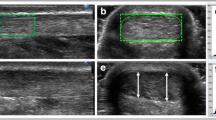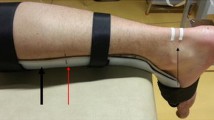Abstract
Introduction
Assessment of the Achilles tendon thickness (ATT) using B-mode ultrasound is a common technique for clinical evaluation of chronic mid-part tendinosis. Currently used image-based assessment is limited by relatively high inter- and intra-observer variability. In this study, it was tested whether a new sequence-based automated assessment of ATT provides more reliable and reproducible results than the standard image-based procedure.
Materials and methods
A total of 118 non-operated tendons of 59 healthy subjects (44, range 28–50 years) were analysed using an automated image based as well as a newly developed automated sequence-based method. Correlation and agreement of both methods were evaluated. The root mean square deviation (RMSD) and a Bland–Altman analysis were performed to highlight observer (n = 18 tendons) as well as reader (n = 40 tendons) dependent variabilities of both methods.
Results
A strong correlation was found between image and sequence-based ATT assessment (p = 0.92). The Bland–Altman analysis showed a good agreement between both methods (mean difference 0.0018, 95 % CI: −0.046; 0.05). In repetitive examinations, sequence-based analysis showed a significant reduction concerning reader- and observer-dependent variability compared to image-based assessment. The RMSD for repetitive sequence-based measurements was approximately 0.3 mm (compared to 0.6 mm for image-based measurement), respectively.
Conclusions
The study shows sequence-based automated assessment of ATT being clearly superior to the standard image-based procedure. The new method provides a clear reduction of reader as well as observer-dependent variability. Due to the decreased scattering of measurement data sequence-based measurement seems especially valuable for quantification of small tendon thickness changes such as exercise-induced hypertrophy.




Similar content being viewed by others
References
Paavola M, Kannus P, Jarvinen TA, Khan K, Jozsa L, Jarvinen M (2002) Achilles tendinopathy. J Bone Joint Surg Am 84-A(11):2062–2076
Schepsis AA, Jones H, Haas AL (2002) Achilles tendon disorders in athletes. Am J Sports Med 30:287–305
Khan KM, Forster BB, Robinson J et al (2003) Are ultrasound and magnetic resonance imaging of value in assessment of Achilles tendon disorders? a two year prospective study. Br J Sports Med 37:149–153
Leung JL, Griffith JF (2008) Sonography of chronic Achilles tendinopathy: a case–control study. J Clin Ultrasound 36:27–32
Martinoli C, Derchi LE, Pastorino C, Bertolotto M, Silvestri E (1993) Analysis of echotexture of tendons with US. Radiology 186:839–843
Dillehay GL, Deschler T, Rogers LF, Neiman HL, Hendrix RW (1984) The ultrasonographic characterization of tendons. Invest Radiol 19:338–341
Fornage BD, Rifkin MD (1988) Ultrasound examination of tendons. Radiol Clin North Am 26:87–107
Paavola M, Paakkala T, Kannus P, Jarvinen M (1998) Ultrasonography in the differential diagnosis of Achilles tendon injuries and related disorders. a comparison between pre-operative ultrasonography and surgical findings. Acta Radiol 39:612–619
Alfredson H, Zeisig E, Fahlstrom M (2009) No normalisation of the tendon structure and thickness after intratendinous surgery for chronic painful midportion Achilles tendinosis. Br J Sports Med 43:948–949
Fredberg U, Bolvig L, Andersen NT (2008) Prophylactic training in asymptomatic soccer players with ultrasonographic abnormalities in Achilles and patellar tendons: the Danish Super League Study. Am J Sports Med 36:451–460
Fredberg U, Bolvig L, Andersen NT, Stengaard-Pedersen K (2008) Ultrasonography in evaluation of Achilles and patella tendon thickness. Ultraschall Med 29:60–65
Syha R, Peters M, Birnesser H et al (2007) Computer-based quantification of the mean Achilles tendon thickness in ultrasound images: effect of tendinosis. Br J Sports Med 41:897–902
Tsouli SG, Xydis V, Argyropoulou MI, Tselepis AD, Elisaf M, Kiortsis DN (2009) Regression of Achilles tendon thickness after statin treatment in patients with familial hypercholesterolemia: an ultrasonographic study. Atherosclerosis 205:151–155
Brushoj C, Henriksen BM, Albrecht-Beste E, Holmich P, Larsen K, Bachmann Nielsen M (2006) Reproducibility of ultrasound and magnetic resonance imaging measurements of tendon size. Acta Radiol 47:954–959
Schmidt WA, Schmidt H, Schicke B, Gromnica-Ihle E (2004) Standard reference values for musculoskeletal ultrasonography. Ann Rheum Dis 963:988–994
Tesch C, Friemert B, Huhnholz J, Wening JV (2008) Significance of sonography in traumatology and orthopedics: part 1: ultrasonography of the musculoskeletal system. Unfallchirurg 111:659–669
Dong Q, Fessell DP (2009) Achilles tendon ultrasound technique. AJR Am J Roentgenol 193:W173
Cheng DCS-TA, Cheng KS, Burkhardt H (2002) Using snakes to detect the intimal and adventitial layers of the common carotid artery wall in sonographic images. Comput Methods Programs Biomed 67:27–37
Schmidt-Trucksass A, Cheng DC, Sandrock M et al (2001) Computerized analysing system using the active contour in ultrasound measurement of carotid artery intima-media thickness. Clin Physiol 21:561–569
Stiskal M, Szolar DH, Stenzel I et al (1997) Magnetic resonance imaging of Achilles tendon in patients with rheumatoid arthritis. Invest Radiol 32:602–608
Conflict of interest
None.
Author information
Authors and Affiliations
Corresponding author
Rights and permissions
About this article
Cite this article
Syha, R., Grau, S., Nieß, A.M. et al. Computer-based quantification of the Achilles tendon thickness in sequential B-mode ultrasound images: a study of feasibility and reliability. Arch Orthop Trauma Surg 134, 1443–1449 (2014). https://doi.org/10.1007/s00402-014-2043-3
Received:
Published:
Issue Date:
DOI: https://doi.org/10.1007/s00402-014-2043-3




